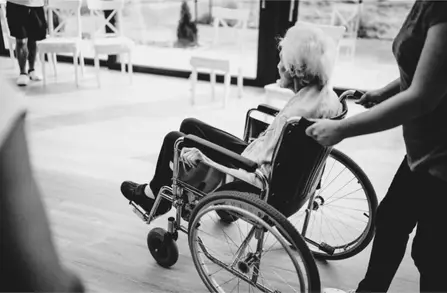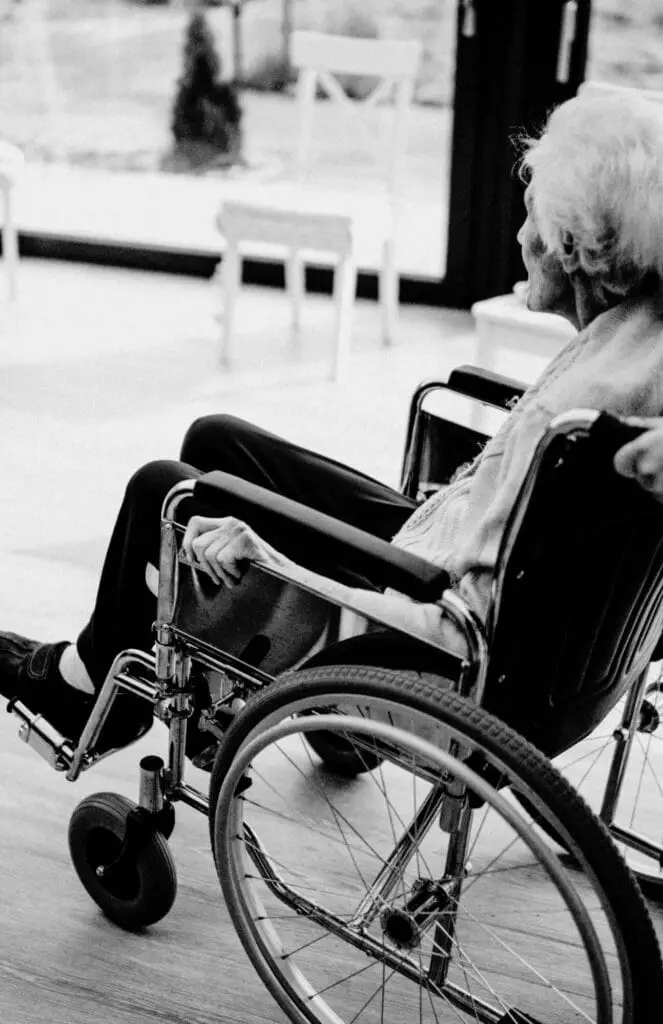Kansas | Missouri | Midwest
Nursing Home Abuse & Neglect
What is Nursing Home Abuse & Neglect?
Nursing home abuse and neglect occurs when a facility or caregiver fails to provide the proper care and attention that a resident requires, leading to harm. Abuse may be physical, emotional, or sexual, while neglect often involves the failure to provide necessary medical care or meet basic needs.
Click on each sub-area below to learn more about your case.

Hoyer Lift Drops
What is a Hoyer Lift Drop Case?
A Hoyer lift drop occurs when a patient or caregiver is dropped from a Hoyer lift, a medical device used to assist in moving patients. This can result in severe injuries, especially for elderly or disabled individuals. The injuries may range from fractures and dislocations to spinal cord injuries.
Common Hoyer Lift Drop Cases
Accidents caused by improper use or lack of training for the caregiver.
Malfunctioning or poorly maintained Hoyer lifts.
Failure to follow safety protocols when operating the lift.
Liability Types
Caregiver Negligence: If the caregiver failed to operate the lift correctly.
Manufacturer Liability: If the lift malfunctions due to a design or manufacturing defect.
Facility Responsibility: If the nursing home or medical facility fails to provide proper training or maintenance.
Common Causes
Inadequate staff training on how to safely use Hoyer lifts.
Lack of regular equipment inspections or maintenance.
Failure to follow safety protocols during patient transfers.
Types of Compensation
Medical Expenses: Coverage for injuries caused by the drop, including hospitalization and rehabilitation.
Pain and Suffering: Compensation for physical and emotional distress.
Lost Wages: If the caregiver or patient is unable to work due to the injury.
What to Do After a Hoyer Lift Drop
Seek medical attention immediately, even if injuries seem minor.
Document the incident and report it to the facility.
Gather evidence, such as photos of the scene and medical records.
Report to the event to the relevant state hotline.
Contact an attorney with experience in medical malpractice and personal injury to evaluate your case.
Burn & Scalding Injuries
- Accidents caused by defective household appliances or heating equipment.
- Workplace injuries involving chemical burns or fires.
- Burns from electrical malfunctions or exposure to high-voltage electricity.
- Scalding injuries from hot water in bathtubs or showers.
- Product Liability: If a defective product caused the injury.
- Employer Responsibility: If the injury occurred due to unsafe working conditions.
- Premises Liability: If an unsafe property condition led to the injury.
- Faulty or defective equipment.
- Workplace accidents involving chemicals or flammable substances.
- Negligence in properly maintaining heat sources or electrical wiring.
- Medical Expenses: For treatments such as burn care, surgeries, and rehabilitation.
- Pain and Suffering: Compensation for the long-term physical and emotional toll of burn injuries.
- Lost Wages: If the injury results in time off work.
- Disfigurement: Compensation for permanent scarring or disability.
- Seek immediate medical treatment for burns, even if they seem minor.
- Report the accident to the appropriate authorities or employer.
- Collect evidence, such as photographs of the injury and the scene of the accident.
- Contact a lawyer experienced in burn injury cases to discuss your legal options.
Choking
What is a Choking Injury Case?
Choking injuries occur when a person’s airway becomes blocked by a foreign object, food, or other materials. If not addressed immediately, choking can lead to severe damage to the brain or organs, and in some cases, it can be fatal. These incidents are common in children and elderly adults but can occur at any age.
Common Choking Injury Cases
Patients or residents choking on small objects or food, sometimes due to medical conditions such as dysphagia (difficulty swallowing).
Choking often occurs in nursing homes or healthcare facilities due to improper supervision or feeding practices.
Liability Types
Caregiver Negligence: If a caregiver or facility failed to feed a patient food that is appropriate for their medical condition, or if they fail to monitor or assist the patient while eating.
Common Causes
Improper or rushed feeding in a nursing home setting.
Failure to serve the patient or resident a soft diet when needed.
Lack of proper emergency response or equipment to handle choking incidents.
Types of Compensation
Medical Expenses: Coverage for treatments required for injuries sustained during the choking event.
Pain and Suffering: For the emotional and physical trauma resulting from the choking.
Loss of Life: If choking leads to fatality, compensation for the wrongful death of the victim.
What to Do After a Choking Incident
Seek immediate medical attention for the victim to ensure their airway is cleared.
Document the incident and gather any relevant information or evidence.
If the incident occurred at a facility, report it to the proper authorities or state hotline.
Contact an attorney specializing in personal injury to discuss your options.
Elopement (Wandering)
What is an Elopement Case?
Elopement occurs when a patient or resident, often from a nursing home, memory care facility, or assisted living facility, leaves the premises unsupervised. Elopement incidents can result in significant harm or even death if the individual is unable to safely navigate the outside world due to medical conditions such as dementia or physical impairments.
Common Elopement Cases
A patient with dementia wandering away from a nursing home and suffering an accident.
An elderly resident with physical limitations leaving the facility and being injured by traffic.
Patients escaping due to inadequate security or supervision in healthcare facilities.
Liability Types
Facility Negligence: If a healthcare facility failed to secure exits or supervise vulnerable residents.
Caregiver Negligence: If a caregiver did not ensure the patient’s safety during daily activities.
Common Causes
Inadequate security measures or lack of supervision.
Insufficient staff training to deal with wandering or elopement risks.
Poorly maintained or unsecured premises, allowing easy access to exits.
Types of Compensation
Medical Expenses: For injuries sustained from falls, traffic accidents, or exposure.
Pain and Suffering: Compensation for the victim’s emotional and physical distress.
Punitive Damages: In cases of gross negligence or poor facility management.
What to Do After an Elopement Incident
Immediately locate and provide medical care for the individual.
Notify the authorities and the facility about the incident.
Document the circumstances of the elopement and the facility’s security measures.
Contact a lawyer experienced in nursing home or personal injury cases.
Sexual Assault & Abuse
What is a Sexual Assault & Abuse Case?
Sexual assault and abuse cases involve physical, emotional, or psychological harm caused by sexual violence. Victims of sexual assault and abuse can include adults, children, and vulnerable individuals in institutions such as nursing homes, schools, and foster care. These crimes can cause lasting trauma and often require legal intervention for justice and compensation.
Common Sexual Assault & Abuse Cases
Abuse in nursing homes or assisted living facilities.
Assaults within schools, including teacher-student abuse.
Child abuse cases, particularly in foster care or daycare settings.
Sexual assault in hospitals or medical facilities.
Liability Types
Perpetrator Liability: The individual responsible for the assault.
Institutional Liability: If a school, daycare, or nursing home failed to prevent abuse.
Negligent Supervision: If a facility or employer didn’t adequately supervise staff or residents.
Common Causes
Inadequate background checks for employees in vulnerable sectors.
Lack of supervision in childcare or senior care settings.
Institutional cover-up of abuse or exploitation incidents.
Types of Compensation
Medical Expenses: For treatment of physical and psychological injuries.
Pain and Suffering: Compensation for the emotional and mental distress caused by the abuse.
Punitive Damages: If the responsible party acted with malice or gross negligence.
What to Do After Sexual Assault or Abuse
Seek medical care for both physical and psychological support.
Report the incident to authorities and relevant organizations (e.g., police, child protective services).
Document all details of the assault and potential witnesses.
Consult a lawyer specializing in sexual assault and abuse cases for legal advice.
Resident on Resident Assault
What is a Resident on Resident Assault Case?
Resident on resident assault occurs when one resident of a nursing home or care facility injures another, either intentionally or due to a lack of supervision. These incidents can lead to serious injuries and are often preventable if the facility takes adequate precautions to supervise residents and address aggressive behavior.
Common Resident on Resident Assault Cases
One resident attacking another in a nursing home due to poor supervision.
Violent incidents in assisted living facilities where residents are not properly monitored.
Psychological or physical harm caused by unaddressed behavioral issues.
Liability Types
Facility Negligence: If the facility failed to provide adequate supervision and safety measures.
Staff Responsibility: If staff members did not intervene in time or prevent the violence.
Resident Responsibility: If one resident committed the assault, they may be held liable.
Common Causes
Poor supervision or understaffing in healthcare facilities.
Unresolved behavioral issues among residents that were not addressed.
Inadequate security measures to separate aggressive individuals.
Types of Compensation
Medical Expenses: For injuries caused by the assault.
Pain and Suffering: For physical and emotional trauma.
Loss of Quality of Life: Compensation for the impact of the assault on the victim’s well-being.
What to Do After a Resident on Resident Assault
Seek immediate medical attention for the victim.
Report the incident to facility management and authorities.
Document evidence, including any injuries and the facility’s response.
Falls Resulting in Traumatic Injuries or Death
What is a Fall Injury Case?
Falls are one of the most common causes of serious injury, especially among the elderly. A fall may result in traumatic injuries such as broken bones, head injuries, or spinal cord damage. In some cases, a fall can be fatal. These types of injuries often occur in nursing homes, hospitals, or due to unsafe premises.
Common Fall Injury Cases
Slips or trips due to wet floors or poor lighting in public spaces.
Falls in nursing homes or assisted living facilities caused by neglect or unsafe environments.
Workplace falls due to unsafe ladders or scaffolding.
Falls in healthcare facilities where patient safety protocols were not followed.
Liability Types
Premises Liability: If a property owner or facility failed to maintain a safe environment.
Employer Liability: If a workplace does not provide safety measures to prevent falls.
Medical Negligence: If a healthcare provider fails to properly assist patients at risk of falling.
Common Causes
Wet or uneven floors.
Poor lighting or inadequate signage in public spaces.
Lack of assistance or support in care facilities for at-risk residents.
Unsafe working conditions, such as faulty ladders or scaffolding.
Types of Compensation
Medical Expenses: For treatment of injuries resulting from the fall.
Pain and Suffering: Compensation for emotional and physical trauma.
Lost Wages: If the injury causes the victim to miss work.
Disability Compensation: If the injury results in permanent disability.
What to Do After a Fall Injury
Seek medical attention immediately, even if the injury seems minor.
Report the fall to the responsible parties (facility, employer, or property owner).
Gather evidence such as photographs of the fall site and witness statements.
Consult with a lawyer specializing in premises liability or personal injury cases.
Pressure Ulcers/Bedsores
What is a Pressure Ulcer or Bedsore Case?
Pressure ulcers, also known as bedsores or decubitus ulcers, occur when prolonged pressure on the skin reduces blood flow to a particular area, causing tissue damage. These injuries are common in patients who are immobile, such as those in nursing homes, hospitals, or long-term care facilities. Proper care and monitoring can prevent these ulcers, but when facilities neglect to provide appropriate care, serious consequences can occur.
Common Pressure Ulcer & Bedsore Cases
Development of bedsores in nursing home residents due to lack of repositioning.
Pressure ulcers forming in hospital patients due to inadequate care during recovery.
Cases where patients develop bedsores from improper monitoring in healthcare facilities.
Liability Types
Facility Negligence: If a healthcare facility failed to provide proper care and attention to prevent the development of bedsores.
Caregiver Negligence: If staff failed to reposition patients, monitor their condition, or properly clean and dress the affected areas.
Common Causes
Prolonged immobility without repositioning or support.
Poor hygiene or failure to keep the skin clean and dry.
Inadequate staffing or lack of training in the proper care of bedridden patients.
Types of Compensation
Medical Expenses: Compensation for the cost of treatment and recovery.
Pain and Suffering: Compensation for the physical pain caused by the ulcer.
Disfigurement: If the bedsore results in permanent scarring or deformity.
What to Do After Developing a Pressure Ulcer or Bedsore
Seek immediate medical care to treat the ulcer and prevent further complications.
Report the incident to the appropriate authorities, including the facility or hospital management.
Document the development of the ulcer, the treatment, and any negligence you believe occurred.
Consult with a personal injury attorney to explore your options for compensation.
Urinary Tract Infection (UTI) resulting in Sepsis
What is a UTI Resulting in Sepsis Case?
A urinary tract infection (UTI) is a common condition, but if left untreated or improperly treated, it can progress to sepsis, a severe and life-threatening condition caused by widespread infection in the bloodstream. In healthcare facilities, such as nursing homes, UTIs are common in residents who may not receive proper care, leading to serious complications.
Common UTI Resulting in Sepsis Cases
Elderly residents in nursing homes developing UTIs due to poor hygiene or improper catheter care.
Hospital patients experiencing untreated UTIs leading to sepsis.
Sepsis in patients due to improper monitoring or delayed treatment of UTIs in healthcare settings.
Liability Types
Healthcare Provider Negligence: If a healthcare provider fails to diagnose or treat a UTI promptly.
Facility Negligence: If the nursing home or hospital failed to monitor or provide adequate care to prevent infection.
Common Causes
Inadequate monitoring of elderly or bedridden patients.
Failure to properly clean catheters or other medical devices.
Delayed diagnosis or failure to treat UTIs in a timely manner.
Types of Compensation
Medical Expenses: For treatments related to the infection and sepsis.
Pain and Suffering: Compensation for the emotional and physical toll of the infection.
Wrongful Death: If the infection leads to fatal complications, compensation for wrongful death.
What to Do After a UTI Results in Sepsis
Seek immediate medical treatment to manage the infection and prevent further complications.
Report the incident to the healthcare facility or facility administration.
Document the events leading to the infection and any signs of negligence.
Consult a lawyer to discuss legal options and seek compensation for harm.
Assisted Living Major Injury & Death
What is an Assisted Living Major Injury & Death Case?
Assisted living facilities provide support to individuals who cannot fully care for themselves but do not require full-time nursing home care. Unfortunately, some of these facilities fail to properly care for residents, leading to major injuries or even fatalities. These cases typically involve neglect, lack of proper supervision, or unsafe living conditions.
Common Assisted Living Injury & Death Cases
A resident falling due to improper supervision or unsafe facility conditions.
A death caused by inadequate medical care or delayed intervention in an emergency situation.
Severe injuries resulting from physical abuse or neglect by staff.
Liability Types
Facility Negligence: If the assisted living facility failed to maintain safe living conditions, provide adequate supervision, or give appropriate medical care.
Caregiver Negligence: If staff members failed to properly care for or monitor the resident.
Common Causes
Understaffing or lack of qualified caregivers.
Unsafe living conditions, such as poorly maintained furniture or floor surfaces.
Failure to properly address medical emergencies or provide adequate supervision.
Types of Compensation
Medical Expenses: For treatment related to injuries sustained in the facility.
Pain and Suffering: Compensation for the pain and distress caused by the injury or death.
Wrongful Death: If the death was the result of neglect or abuse, compensation for loss of life and related damages.
What to Do After a Major Injury or Death in Assisted Living
Seek medical attention immediately to address any injuries.
Report the incident to the appropriate authorities and investigate the facility’s involvement.
Collect evidence such as photos, medical records, and witness statements.
Consult with an experienced attorney to explore your legal options and file a claim.

